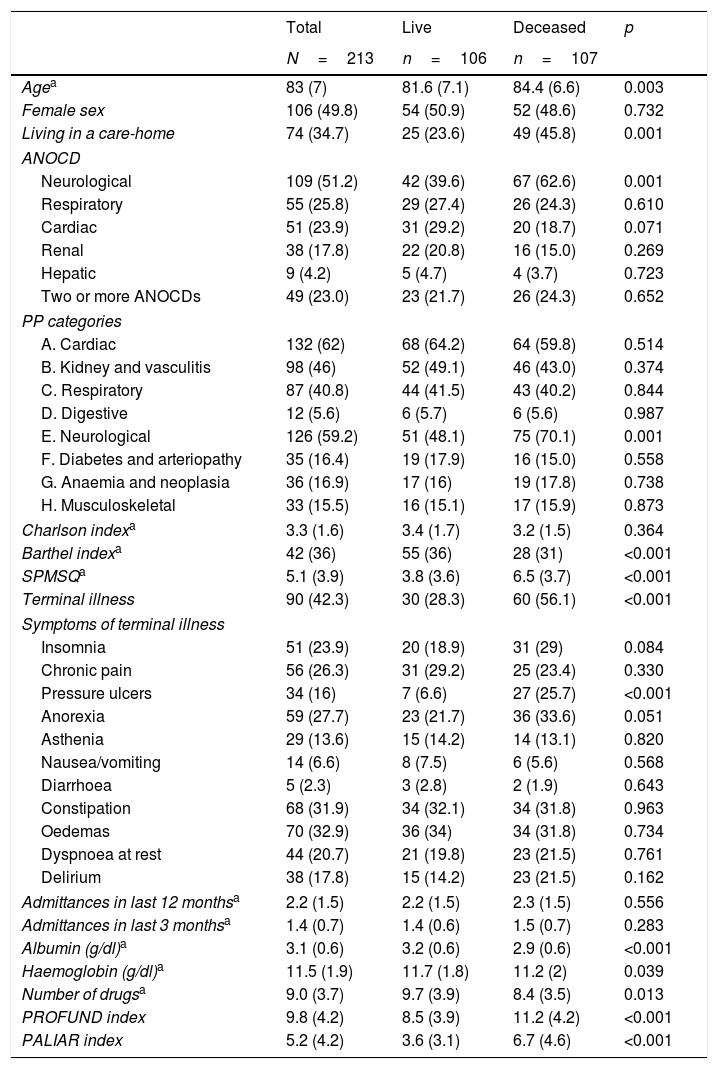To compare the discrimination power of PROFUND and PALIAR indexes for predicting mortality in polypathological patients with advanced non-oncologic chronic disease.
Material and methodsProspective multicentre cohort study. We included polypathological patients with advanced non-oncologic chronic disease, who were admitted to internal medicine departments between July 1st and December 31st, 2014. Data was collected from each patient on age, sex, categories of polypathology, advanced disease, comorbidity, functional and cognitive assessment, terminal illness symptoms, need for caregiver, hospitalisation in the past three and 12 months and number of drugs. We calculated the PROFUND and PALIAR indexes and conducted a 12-month follow-up. We assessed mortality with the Kaplan–Meier survival curves and the discrimination of indexes with the ROC curves.
ResultsWe included 213 patients with a mean (standard deviation) age of 83.0 (7.0) years, 106 (49.8%) of whom were female. Mortality at six months was 40.4% and at 12 months 50.2%. Deceased patients scored higher scores on the PROFUND [11.2(4.2) vs 8.5(3.9); p<0.001] and PALIAR [6.7 (4.6) vs 3.6(3.1); p<0.001] indexes. The discrimination of PALIAR index at six months (under the curve area 0.734 95%CI 0.665–0.803) was higher than of PROFUND, and there was no difference at 12 months.
ConclusionsIn polypathological patients with advanced non-oncologic chronic disease, the PALIAR index had better discrimination power than PROFUND index at 66 months and there were no differences at 12 months.
Comparar la rentabilidad de los índices PALIAR y PROFUND para predecir la mortalidad en pacientes pluripatológicos con enfermedad crónica no oncológica en fase avanzada.
Material y métodosEstudio de cohortes, prospectivo y multicéntrico con pacientes pluripatológicos con enfermedades crónicas no oncológicas en fase avanzada ingresados en departamentos de medicina interna entre el 1 de julio y el 31 de diciembre de 2014. Se recogieron datos de edad, género, categorías de pluripatología, enfermedad avanzada, comorbilidad, valoración funcional y cognitiva, síntomas de enfermedad terminal, necesidad de cuidador, ingresos en los 3 y 12 meses previos, número de fármacos, y se calcularon los índices PROFUND y PALIAR. Tras un seguimiento durante 12 meses la mortalidad se valoró con las curvas de supervivencia de Kaplan-Meier y la rentabilidad de los índices con las curvas ROC.
ResultadosSe incluyeron 213 pacientes con edad media 83 (7) años y 106 (49,8%) eran mujeres. La mortalidad a los 6 meses fue del 40,4% y a los 12 del 50,2%. Los pacientes fallecidos puntuaban más alto en los índices PROFUND [11,2(4,2) frente a 8,5(3,9); p<0,001] y PALIAR [6,7 (4,6) frente a 3,6 (3,1); p<0,001]. La capacidad discriminativa del índice PALIAR a los 6 meses (área bajo la curva 0,734; IC95% 0,665-0,803) fue superior a la del índice PROFUND y no hubo diferencias a los 12 meses.
ConclusionesEn pacientes pluripatológicos con enfermedad crónica en fase avanzada el índice PALIAR tiene un rendimiento mayor que el índice PROFUND para predecir la mortalidad a los 6 meses y similar a los 12 meses.
Artículo
Comprando el artículo el PDF del mismo podrá ser descargado
Precio 19,34 €
Comprar ahora










